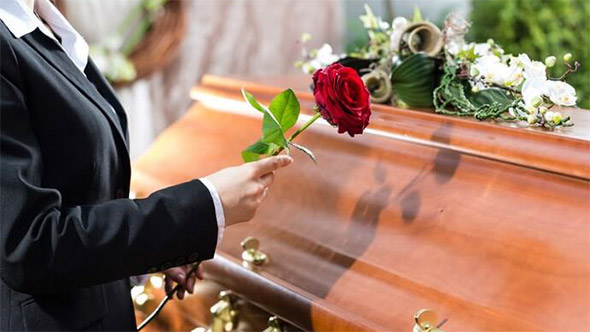What is the Christian meaning of death?
Our religious beliefs define our concept of suffering and death. In fact, each religion offers responses to these human realities which, by themselves, raise many questions, and even cause fears and serious anxieties. For Christians, the meaning of life AND death can be summed up in one word: Jesus.
The Christian lives and dies WITH Jesus, God the Only-begotten Son, who came to Earth to reveal the infinite love of God to each and every one of us. This infinite love of the Father was manifested itself in each second of Jesus’ life, but never more than in the dramatic hours of His Passion, when He was put to death, and in His Resurrection. The Passion and the Resurrection of Jesus therefore enlightens the mystery of death, and conveys the Christian meaning of it: everyone must unite with the death of Christ, die with Him and in Him, and then be resurrected with Him in God’s Kingdom. Death, with and for Jesus, then becomes a passage toward eternal communion with God and all the saints (including our loved ones who have died before us), in a life of eternal happiness, infinitely beyond all the longings of the human heart.
Faith in Jesus Christ, who died and was resurrected for each one of us, thus makes it possible to consider death while separating it from anguish, from obscurity, from nothingness, from a definitive separation from the human community and from our loved ones who died before us, and to disqualify also the conceptions of the afterlife that the Church considers erroneous, such as reincarnation and other non-Christian beliefs.
In summary, for Christians, death will always be the definitive passage towards the supreme fulfillment of a person’s destiny: the personal encounter with the Triune loving God, while waiting for the resurrection of the flesh, in communion with all the saints, within the great family of God, finally reunited for all eternity.
What to do when a baptized person dies ?
First and foremost, it is important to know the last wishes of the deceased person. In the case of a person who was baptized in the Catholic Church, it is strongly recommended that close relatives of the deceased get in touch with their parish community as soon as possible to find out about the steps and rites related to the final farewell.
1- Death certificate (statement of death drawn up by a physician)
The death certificate of a person is required before one can proceed with the funeral arrangements. This process is automatic when the death occurs in a hospital; in the case of a death occurring at home, one can call 9-1-1 to obtain it.
If necessary, the presence of two or three people from the family of the deceased will provide the authorization required for the opening of the will and for the purpose of determining the last testament, including the name of the person designated as executor. If the last wishes of the deceased person regarding the funeral are already known, and no one contests the choice of the executor, it is preferable to delay the reading of the will until later, in the presence of a notary, if needed.
2- Notifying the Church
- Set up a meeting at the church
- Determine the dates and sequence in the planning
It is best to contact the church immediately (Find a church here), where the family wishes the funeral to take place, before contacting a funeral home. The meeting at the church with the priest (or the person designated by him) will help to clarify the wishes of the family, including the sequence in the planning that include the funeral arrangements, such as :
-
the vigil (funeral home)
-
the tribute (funeral home)
-
the liturgy (funeral home or church)
-
the funeral Mass (church)
-
the burial of the body (cemetery) or the disposition of the ashes (columbarium)
The priest and/or the delegate for the preparation of the funeral celebration have as their mission to tend to the deceased person. They have another, perhaps a more important, mission which is to also tend to the suffering of relatives and the contrasting emotions that death arouses; a mission of listening, full of empathy and deep concern.
3- Notifying the funeral home
- Fill out the required forms
- Confirm dates and sequence in the planning
- Prepare the death notice indicating time and place of the arrangements
- Select the casket
- Contact the cemetery or crematorium
- Organize the buffet for after the funeral
What are the different arrangements to plan?
1- The vigil (at the funeral home)
The funeral vigil, usually held at the funeral home, is a time-honored tradition that allows the loved ones of the deceased to live the reality of death. It is an opportunity for relatives of the deceased person to meet and receive condolences and the comfort of visitors. For the faithful, it is also an opportunity to gather and pray.
2- The tribute (at the funeral home)
More and more, it is recommended that friends and family of the deceased be invited to a tribute to remember the deceased person, to be held during the evening of the wake. This celebration of life, which lasts about 30 minutes and is led by a qualified person, will give people a chance to hear stories about the deceased, pay tribute, sing songs or play pieces of music that the deceased loved, read beautiful literary texts, and present photo montages or videos.
3- The liturgy (at the funeral home or in church)
In the Catholic Church, funerals must be granted to the faithful departed when requested (Canon Law 1176, 1). For the Church, the purpose of a funeral is twofold: for the deceased, to ensure rest and peace for the soul while honoring the body; and for the mourners, to support them and to offer new or renewed hope for an eternal and blessed life with God.
The funeral is held in the presence of the body or the ashes of the deceased. Until recently, traditional funerals included a funeral Mass held at the church, with organ music and liturgical hymns. Nowadays, many families prefer to have a Liturgy of the Word at the funeral home, following the tribute, which is presided by a designated minister of the parish.
This Liturgy of the Word plays a very important role. Indeed, the proclamation of readings from the Bible remind us of God’s forgiveness offered to all human beings by the sacrifice of love of Jesus on the cross. The promise of God through Jesus also nourishes the hope that we will be reunited for eternity, one day, in God’s Kingdom. The proclaimed Word also reminds us of the deep ties that unite the living and the dead in the mystery of the Communion of Saints (a dogma of the Church). Lastly, this Word recalls the importance of living and dying in an authentically Christian way. To recall these truths is important and that is why only Scripture, and not secular texts, can be read and commented on in church. The biblical texts illuminate the mystery of God, of life and death, on the longing of human beings for eternal happiness, of the salvation offered by God, Father of infinite mercy, through his Son, Jesus.
Since the Liturgy of the Word in a funeral home is NOT a funeral Mass, the Catholic Church recommends that Mass be celebrated in the days following the vigil. The sequence of the funeral Mass will already have been planned by the family members of the deceased with the person responsible for funerals at their chosen parish.
4- The funeral Mass (in church)
Once the Liturgy of the Word has taken place at the funeral home, one must make sure that a funeral Mass is held for the repose of the soul of the deceased. At this Mass, the deceased person is united to the Lord Jesus Christ and is offered with Him to God the Father at the memorial of the death and resurrection of Christ. The distribution of communion is part of this celebration. For the faithful, it is an intense moment of communion with the Lord, the deceased and all those who mourn the departure of the deceased.
5- Burial of the body at the cemetery or placing the ashes in a columbarium
The burial of the body of a Catholic person is normally done in a Catholic cemetery or in a columbarium. The Church allows the body to be cremated, but only after the funeral is celebrated, if possible. That being said, out of respect for the sanctity of the body of the deceased (that was inhabited by God), the Church recommends that the ashes should not be kept at home, nor be used in any particular way, such as spread outside in the wind, in water or on the ground. It is recommended that the ashes be buried in a cemetery or be placed in a columbarium.

